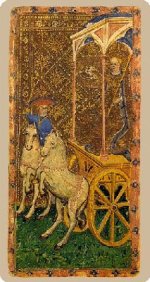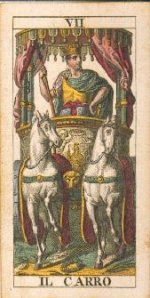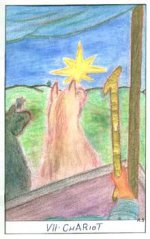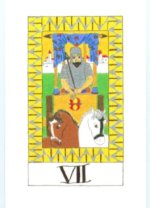catboxer
The earliest versions of the Chariot are much different from what came later. In both the Cary-Yale Visconti deck and the Visconti-Sforza, the car is pulled by prancing horses, and the driver is a female. These are obviously not war chariots, and possibly the patrons, who were at least partially responsible for the content of the packs they would use for gaming, specified that they wanted no overt references to war in their cards. So both of these pictures show a chariot in a triumphal celebration or parade, of a type common in Italy since Roman times. "Triumph" is the root of the word we use to designate the 22 cards under study here ("trump"), and while the elements of the picture changed within the first 200 years of tarocchi, the theme of "victory" remained. In fact, some of the early versions of this card are called Victory.
Unfortunately, there are very few chariot cards remaining on the uncut decks that give us most of our information about early Italian woodblock packs, but the one I've referred to several times before (Kaplan, V. II, p. 286) has the bottom half of this card, showing only two tiny horses. There's no way of telling whether the driver is male or female.
The crowned, male warrior appears in the earlist Marseilles decks. In the mid-17th-century Noblet Tarot, the card has already taken on all the characterisitics it will possess in the classic Marseilles tradition, including the horses whose bodies seem to emanate from the same point of origin, due to woodblock artists' difficulties in handling perspective representation in a very tight space.
However, the possibly slightly earlier Jacques Vieville deck's chariot is drawn not by horses, but by the two sphinxes that would not appear in tarot again for 150 years. This is an extremely significant detail, and whether the French occultists of the 19th century knew of it is anybody's guess. I've always assumed that E. Levi transformed the horses into sphinxes on his own initiative, in a lame attempt to ascribe an Egyptian origin to the cards. The Vieville deck is an extremely interesting study, and it may be the most important known link between the Italian and French tarot traditions. There are important details of it that I have never seen in any other deck, and some of the cards, such as trump XVI, appear to follow an Italian rather than classical French pattern which, as such, didn't exist yet at that time.
I always think of this card as representing victory, but victory is a somewhat vague term embracing such ideas as "victory over caffeine addiction." I believe this card implies serious conflict, even though the earliest patrons of tarot creation tried to soft-peddle the fact that a chariot is a war weapon. It may or may not be referring to a physical conflict, but I most often interpret this card as "a chance to triumph over one's adversaries."
Dave B
Unfortunately, there are very few chariot cards remaining on the uncut decks that give us most of our information about early Italian woodblock packs, but the one I've referred to several times before (Kaplan, V. II, p. 286) has the bottom half of this card, showing only two tiny horses. There's no way of telling whether the driver is male or female.
The crowned, male warrior appears in the earlist Marseilles decks. In the mid-17th-century Noblet Tarot, the card has already taken on all the characterisitics it will possess in the classic Marseilles tradition, including the horses whose bodies seem to emanate from the same point of origin, due to woodblock artists' difficulties in handling perspective representation in a very tight space.
However, the possibly slightly earlier Jacques Vieville deck's chariot is drawn not by horses, but by the two sphinxes that would not appear in tarot again for 150 years. This is an extremely significant detail, and whether the French occultists of the 19th century knew of it is anybody's guess. I've always assumed that E. Levi transformed the horses into sphinxes on his own initiative, in a lame attempt to ascribe an Egyptian origin to the cards. The Vieville deck is an extremely interesting study, and it may be the most important known link between the Italian and French tarot traditions. There are important details of it that I have never seen in any other deck, and some of the cards, such as trump XVI, appear to follow an Italian rather than classical French pattern which, as such, didn't exist yet at that time.
I always think of this card as representing victory, but victory is a somewhat vague term embracing such ideas as "victory over caffeine addiction." I believe this card implies serious conflict, even though the earliest patrons of tarot creation tried to soft-peddle the fact that a chariot is a war weapon. It may or may not be referring to a physical conflict, but I most often interpret this card as "a chance to triumph over one's adversaries."
Dave B







